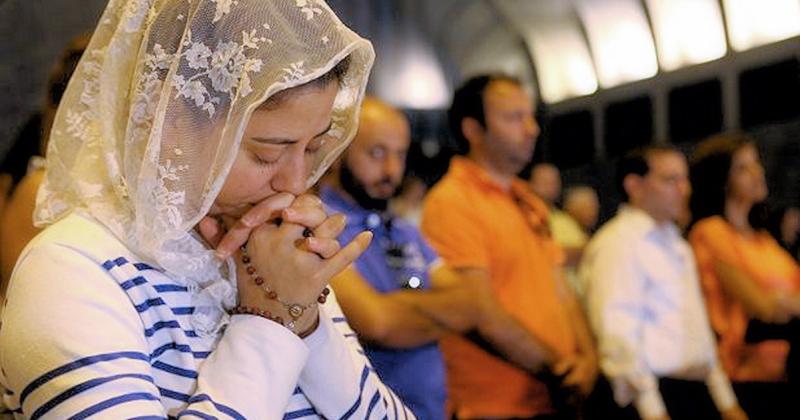Faithful gather inside the Shrine Church of St. Charbel at the St. Maron Monastery in Annaya, Lebanon. (photo: Sarah Hunter)
As noted on Tuesday, the fortunes of the Maronites are often tied to those of Lebanon; to separate either of these symbiotic entities would do neither of them justice. But equally inaccurate is the suggestion that to be Maronite is to be Lebanese, or vice versa.
The Maronite Church is rooted in the asceticism of the desert saints from Asia Minor, Egypt, Palestine and Syria — provinces of the Roman Empire that eventually evolved into Byzantium when Constantine moved the capital of the empire to the Greek port of Byzantium.
Throughout the fourth and fifth centuries, thousands of men and women, following the Gospel’s call to “pray always,” withdrew from society and dedicated themselves to prayer and penance. One such hermit, a priest named Maron, repaired to a hilltop near the city of Aleppo, located in modern Syria. According to one fifth-century bishop, Maron lived a solitary life of fasting and prayer, attaining a “wealth of wisdom.”
Maron died in 410. Carrying with them the skull of the revered priest, his disciples — known as Maronites — formed Beit Maron (Syriac, meaning “house of Maron”), a monastic community near the great city of Antioch, capital of the empire’s province of Syria. There, the Byzantine Emperor Marcian sponsored the construction of the monastery, which was dedicated in 452.
The development of the Maronite community coincided with the great debates that rocked the early church in the eastern Mediterranean. And as the church, particularly in the East, became intricately linked to the imperial Byzantine state, the positions assumed by competing parties took on political overtones. The early Maronites were Hellenized Semites, natives of Byzantine Syria who spoke Greek and Syriac yet identified with the Greek-speaking populace of Constantinople and Antioch.
Where were the monks of Beit Maron in this political, social and theological upheaval? Little evidence remains. What has survived has triggered more than a century of debate among historians, particularly in Maronite circles. The general consensus, however, concludes that the Beit Maron community, as loyal subjects of the Byzantine emperor, accepted the decrees of the ecumenical councils called by the emperors to bring unity to church and commonwealth. Whether or not they implemented them among the local Syriac-speaking Christian community, forming the nucleus of the Maronite Church as claimed, is not clear.
The Arab Muslim annexation of Syria in the mid-seventh century altered the position of the followers of St. Maron. With contacts with Constantinople severed, Antioch in Muslim hands, and its ecclesial situation in disarray, the monks of Beit Maron elected one of their own as patriarch of Antioch. Tradition has it this first patriarch of Antioch of the Maronites, St. John Maron, was elected in 685.
Exposed by the fluidity and uncertainty of the environment, bands of Maronites began to seek refuge in the northern reaches of Mount Lebanon, where they established autonomous communities and formed alliances among themselves while pledging fealty to the patriarch. There, they tenaciously defended their autonomy, repeatedly attacking Arab positions and harassing Byzantine scouts eager to retake the area.
Ironically, the Maronites flourished despite the destruction of Beit Maron in the ninth century and the relocation of the Maronite patriarchate to a monastery near the coastal town of Batroun.
